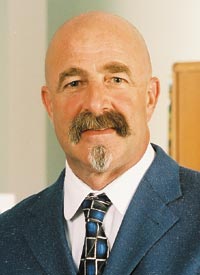2005 Articles
Feeding Assembly Innovation
 |
| Hover-Davis’ John Hover |
Since 1989, Hover-Davis (hoverdavis.com) has made its place in the placement business by building component feeders. The company was founded by a pair of former Eastman Kodak engineers, John Hover and Peter Davis. Hover remains CEO and president and Davis is chief technical officer. Hover spoke with Circuits Assembly’s Mike Buetow in November.
CA: You tout nearly all of the major EMS companies among your customers. What is it about your feeders that attract these A-list companies?
JH: The most compelling reason is overall value. Focusing on value at the feeder level provokes design criteria we feel are unique in the industry. Our target is to provide a world-class solution taking into consideration many key attributes, including robustness, speed, serviceability, flexibility, ease of use and, especially, price. At the same time, we surround our products with a solid support infrastructure, making it easy for our customers to do business with us.
CA: Historically, you've gone head-to-head with placement equipment manufacturers. How is that changing?
JH: By focusing exclusively on feeders and feeding technology for the last 15 years, we have truly become experts is this area. We are confident that our tape feeders provide the best overall performance and value in the market. We have expanded our product portfolio beyond just tape feeding. Today, we offer feeding solutions for direct die feeding from wafer and waffle packs, label feeding, JEDEC tray feeding, as well as feeder intelligence for material tracking and control. As we continue to expand into specialized feeder market segments and the placement equipment makers continue to try to reduce costs, improve performance and reduce time to market, we are seeing more and more partnership opportunities, and are adjusting our business model accordingly.
CA: How is this changing nature affecting your product roadmap?
JH: It is having a profound effect. We are shifting from a very product-centric development focus to a balance between technology and product development. Our definition here of technology is not necessarily traditional; it is more developing all the necessary building blocks to deliver them on our overall value proposition for whatever feeding solution is required. It is becoming increasingly important to have a comprehensive set of these building blocks available to be able to rapidly develop into feeding solutions for our partners and customers.
CA: What technology advancements do you see for the next 18 months? Where do 0201s and 01005s fit in? And what about wafer-level components?
JH: Over the next 18 months, we expect to see 0201s broadly used in high-volume production and 01005s becoming more common. Combined with the reduction in component size, we expect continued focus on increasing presentation speeds, below 50 msec/component, and changes in the presentation media, such as 4 mm wide, 1 pitch tape. We are well prepared for 0201s and the requirements of today’s placement equipment. However, keeping pace with these new requirements in speed, accuracy, quality, reliability and new feeding media requires continuous innovation. As a result, we invest significant money and resources into R&D annually to ensure that we stay at the forefront.
Regarding bare die and wafer-level components, we have been anticipating their emergence for a long time. Almost 10 years ago, we worked with a placement equipment manufacturer that felt there was an opportunity to change the way these devices were assembled. With the emergence of flip chip, multichip packaging and SIP (system-in-package), we felt the assembly processes for die and SMT components were converging. We saw this as an opportunity to lead the market, so in response we developed the Direct Die Feeder.
CA: That feeder boasts that it “can turn almost any chip shooter into a flip-chipshooter, almost any SMT machine into an advanced semiconductor assembly solution and almost any custom automation platform into a flexible semiconductor assembly solution.” Is part of your strategy to make the feeder as technically important as the placement machine itself?
JH: In some cases it may be, and in others not. Our strategy in general is more about enabling the placement machine to realize its full potential, in terms of capability, performance and cost of ownership. Specifically for our die feeding, SMT and custom assembly platforms have evolved significantly over the last 10 years to the point where they can also handle requirements for semiconductor assembly. The main gap was mainly the ability to feed in the die at high speed and with high reliability. These feeders close this gap. As proof, we have adapted numerous assembly platforms with our DDfs for semiconductor assembly applications and are assembling hundreds of millions of die per year throughout the world.
CA: What challenges do you see for next year?
JH: We need to continue to find ways to be more effective, more efficient and accelerate our pace in nearly all areas to be ready for market opportunities and adaptable when changes occur. Another big challenge is taking advantage of the opportunities in China, including better engagement of customers as well as sourcing and manufacturing. In 2006, we will break new ground on many fronts, which should make it a very interesting, exciting and challenging year.
Press Releases
- 2026 IEEE Electronic Components and Technology Conference Student Innovation Challenge Pre-registration Deadline Extended to January 11, 2026
- PCBsync PCB Assembly Introduces Full-Scale Electronic Manufacturing Service
- Magic Leap Partners with Pegatron for AR Glasses Components Production
- TEXMAC/Takaya Appoints ARK Mfg. as New Rep in Arizona







